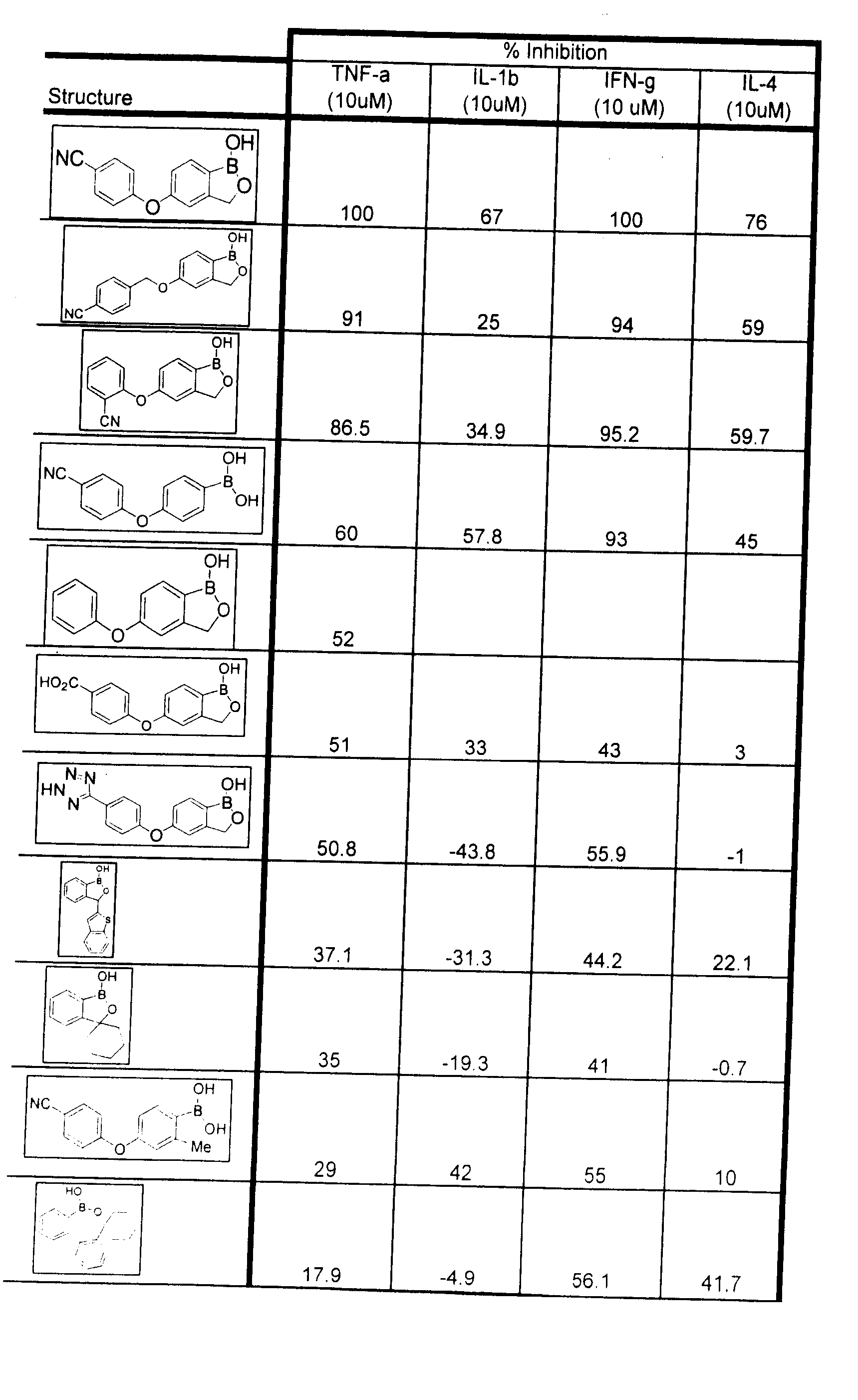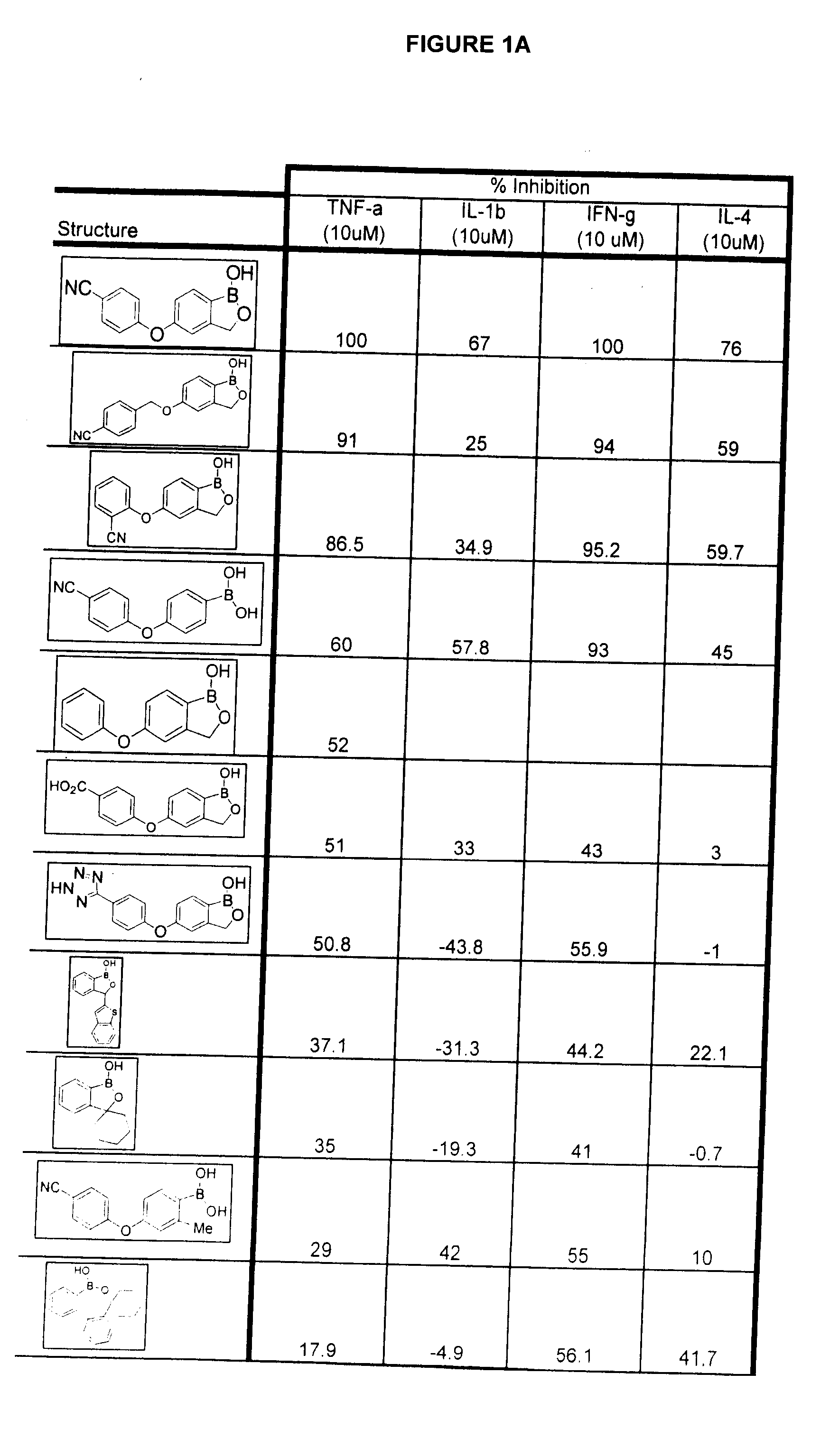Boron-containing small molecules as Anti-inflammatory agents
a small molecule and boron technology, applied in the direction of antibacterial agents, organic active ingredients, antivirals, etc., can solve the problems of inflammation or infection, life-threatening diseases in advanced stages, and generally unsatisfactory,
- Summary
- Abstract
- Description
- Claims
- Application Information
AI Technical Summary
Benefits of technology
Problems solved by technology
Method used
Image
Examples
example 1
Preparation of 3 from 1
1.1 Reduction of Carboxylic Acid
[0214] To a solution of 1 (23.3 mmol) in anhydrous THF (70 mL) under nitrogen was added dropwise a BH3 THF solution (1.0 M, 55 mL, 55 mmol) at 0° C. and the reaction mixture was stirred overnight at room temperature. Then the mixture was cooled again with ice bath and MeOH (20 mL) was added dropwise to decompose excess BH3. The resulting mixture was stirred until no bubble was released and then 10% NaOH (10 mL) was added. The mixture was concentrated and the residue was mixed with water (200 mL) and extracted with EtOAc. The residue from rotary evaporation was purified by flash column chromatography over silica gel to give 20.7 mmol of 3.
1.2 Results
[0215] Exemplary compounds of structure 3 prepared by the method above are provided below.
1.2.a 2-Bromo-5-chlorobenzyl Alcohol
[0216]1H NMR (300 MHz, DMSO-d6): δ 7.57 (d, J=8.7 Hz, 1H), 7.50-7.49 (m, 1H), 7.28-7.24 (m, 1H), 5.59 (t, J=6.0 Hz, 1H) and 4.46 (d, J=6.0 Hz, 2H) ppm.
1...
example 2
Preparation of 3 from 2
2.1. Reduction of Aldehyde
[0218] To a solution of 2 (Z=H, 10.7 mmol) in methanol (30 mL) was added sodium borohydride (5.40 mol), and the mixture was stirred at room temperature for 1 h. Water was added, and the mixture was extracted with ethyl acetate. The organic layer was washed with brine and dried on anhydrous sodium sulfate. The solvent was removed under reduced pressure to afford 9.9 mmol of 3.
2.2 Results
[0219] Exemplary compounds of structure 3 prepared by the method above are provided below.
2.2.a 2-Bromo-5-(4-cyanophenoxy)benzyl Alcohol
[0220]1H-NMR (300 MHz, CDCl3) δ (ppm) 2.00 (br s, 1H), 4.75 (s, 2H), 6.88 (dd, J=8.5, 2.9 Hz, 1H), 7.02 (d, J=8.8 Hz, 1H), 7.26 (d, J=2.6 Hz, 1H), 7.56 (d, J=8.5 Hz, 1H), 7.62 (d, J=8.8 Hz, 2H).
2.2.b 2-Bromo-4-(4-cyanophenoxy)benzyl Alcohol
[0221]1H NMR (300 MHz, DMSO-d6): δ 7.83 (d, 2H), 7.58 (d, 1H), 7.39 (d, 1H), 7.18 (dd, 1H), 7.11 (d, 2H), 5.48 (t, 1H) and 4.50 (d, 2H) ppm.
2.2.c 5-(4-Cyanophenoxy)-1-Indanol...
example 3
Preparation of 4 from 3
3.1 Protective Alkylation
[0225] Compound 3 (20.7 mmol) was dissolved in CH2Cl2 (150 mL) and cooled to 0° C. with ice bath. To this solution under nitrogen were added in sequence N,N-di-isopropyl ethyl amine (5.4 mL, 31.02 mmol, 1.5 eq) and chloromethyl methyl ether (2 mL, 25.85 mmol, 1.25 eq). The reaction mixture was stirred overnight at room temperature and washed with NaHCO3-saturated water and then NaCl-saturated water. The residue after rotary evaporation was purified by flash column chromatography over silica gel to give 17.6 mmol of 4.
3.2 Results
[0226] Exemplary compounds of structure 4 prepared by the method above are provided below.
3.2.a 2-Bromo-5-chloro-1-(methoxymethoxymethyl)benzene
[0227]1H NMR (300 MHz, DMSO-d6): δ 7.63 (d, J=8.7 Hz, 1H), 7.50 (dd, J=2.4 & 0.6 Hz, 1H), 7.32 (dd, J=8.4 & 2.4 Hz, 1H), 4.71 (s, 2H), 4.53 (s, 2H) and 3.30 (s, 3H) ppm.
3.2.b 2-Bromo-5-fluoro-1-[1-(methoxymethoxy)ethyl]benzene
[0228]1H-NMR (300.058 MHz, CDCl3) δ p...
PUM
 Login to View More
Login to View More Abstract
Description
Claims
Application Information
 Login to View More
Login to View More - R&D
- Intellectual Property
- Life Sciences
- Materials
- Tech Scout
- Unparalleled Data Quality
- Higher Quality Content
- 60% Fewer Hallucinations
Browse by: Latest US Patents, China's latest patents, Technical Efficacy Thesaurus, Application Domain, Technology Topic, Popular Technical Reports.
© 2025 PatSnap. All rights reserved.Legal|Privacy policy|Modern Slavery Act Transparency Statement|Sitemap|About US| Contact US: help@patsnap.com



